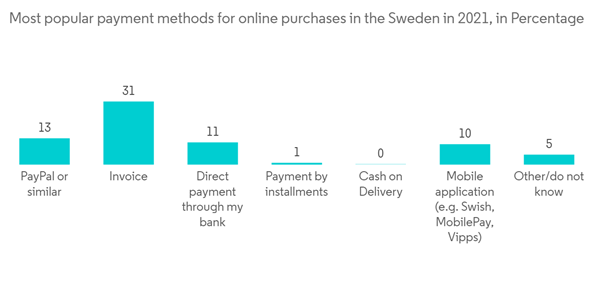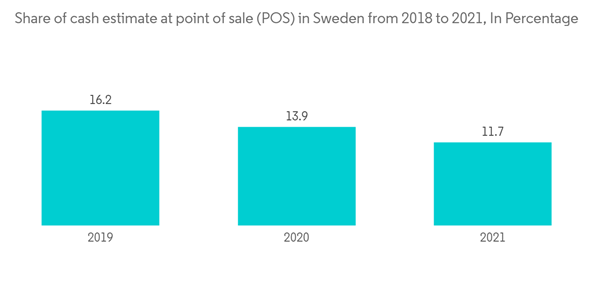Sweden Mobile Payment Market is expected to register a CAGR of 21.3% during the forecast period. Stores and services worldwide are rapidly adopting mobile payment applications, owing to the rapid growth of mobile technology, particularly with the advancement of smartphones. Also, with increasing internet penetration and rapid growth in online retailing, the market is expected to move positively over the forecast period.
This product will be delivered within 2 business days.
Key Highlights
- Sweden, in recent years, has been aiming to adopt contactless payment solutions for its citizens and businesses across the country. For Instance, Sweden recently made all public transport payments cashless, promoting cashless payment solutions. In February last year, Stockholm rolled out an open-loop contactless payment system on public transport across the city. Commuters can now pay for rail, metro, tram, boat trips, and bus fares by tapping their NFC-enabled mobile wallet solution or contactless card against card readers.
- In Sweden, cash payments are progressively being replaced by digital transactions and a growing number of mobile applications. The Riksbank is updating its systems and considering releasing an e-krona to respond to this development. The Riksbank is striving to make sure that using cash is also an option in the future. The country's transactions are often safe, swift, and effective. The Riksbank collaborates with other parties to strengthen the payment system's resistance to interruptions.
- Using a cell phone to make a payment is becoming increasingly frequent. Almost everyone between the ages of 15 and 65 has the Swish app downloaded to their smartphone. Using systems like Apple Pay and Google Pay, for instance, there are now more methods than ever to pay with a mobile device.
- The increasing trend of digital-only banks would support the mobile payment market in the country. For instance, Revolut launched its banking services in the country in January last year. Previously Digital-only bank N26 launched in Sweden in November 2018. Revolut offers business and individual accounts, a Mastercard-branded debit card, digital banking solutions like online payments, POS payment solutions across the country, and mobile payment services.
- Sweden is already at the forefront of adopting mobile payment services for fast and instant payment solutions. Still, these services also have some challenges. Integrating mobile payments still faces difficulties and significant challenges, such as online fraud, cyberattacks, and identity theft. Also, there is an additional cost of setting up new devices (infrastructure) to boost mobile payment solutions with the innovation of technologies like 5G, NFC-enabled devices, and IoT.
- The payment industry is experiencing significant transformation during and after the coronavirus pandemic. Swedish customers are choosing safe digital payments more frequently, lowering the usage of cash and thereby driving them to use contactless mobile and card payments more often when transacting in shops. For example, with Swish, E-commerce and mobile payments are becoming increasingly common. Other payment applications, such as Apple Pay and Google Pay, are becoming more popular.
Sweden Mobile Payments Market Trends
Proximity Segment Would Hold the Major Market Share
- For a very long time, Sweden has been at the forefront of banking innovation. Since then, payments have significantly improved and been made simpler. Sweden is currently paving the path toward a society without cash. In Sweden, the proximity payment market is anticipated to grow throughout the projected period. Following the COVID-19 outbreak, banks, fintech companies, and merchants across the country have been much more interested in proximity payments to enhance digital consumer experiences and cut costs.
- The introduction of Swish in the Swedish market made payment instant and reliable it's a service that allows users to send money from and receive money to their bank accounts via their mobile phones. To 'swish' cash to each other, the payer and the recipient need to be connected to their banks' service.
- Driving the mobile banking payment solution in May last year, Zettle rolled out its new Tap to Pay feature in Sweden, the United Kingdom, and the Netherlands enabling small businesses to accept payments directly on their Android smartphone without using a payment terminal. This solution uses NFC technology based on Proximity already available in most smartphones. It simplifies the payment process for merchants by eliminating the need to acquire a payment terminal.
- Furthermore, nowadays, almost every café, store, and supermarket in Sweden have begun to display QR codes that patrons scan code to make a mobile payment instantly. The Swish app, along with several other significant and little developments, enhances Sweden's status as a country that is becoming increasingly cashless. The QR mode of payment is widely accepted across the country because of its touchless safety, and the encryption makes the payment highly secure.
- The data from GSMA shows that there were 14.37 million cellular mobile connections in Sweden at the start of the previous year. The number of mobile connections in Sweden increased by 60 thousand (+0.4 percent) between 2021 and the last year. With an increase in smartphones, NFC technology drives cashless and contactless payments in the country. For instance, many players like apple pay and PayPal offer payment solutions using NFC technology for in-store, public transport, and bank P2P and P2B transactions using mobile apps like apple pay.
- According to PostNord and Nepa, an Invoice was the most common form of payment for online transactions in Sweden in 2021, followed by debit or credit cards.
Digitalization and Rapid Innovation Would Drive The Market
- People in Sweden are increasingly purchasing online and making digital payments. Swish is available to most people, and other mobile payment systems are also becoming more popular, particularly with younger people. Cash usage is steadily declining. The Nordic nations, particularly Norway, Sweden, and Denmark, are at the forefront of the worldwide trend toward digitizing the payments sector.
- As per the NETS payment outlook for the last year, Sweden, one of the leaders in digital banking, is predicted to be the first cashless nation by the end of this year. For many years, the national bank of Sweden, Riksbank, has been preparing the launch of a purely digital national currency, the Central Bank Digital Currency (CBDC), called e-krona. With the launch of the e- krona and the increasing number of mobile fintech solutions in the region, the prediction has become a reality.
- Sweden's payment regulatory system has a unique way of enabling its citizens to make mobile payments more secure and easy. It involves a BankID mobile app, allowing anyone with a Swedish (personal identification number) and bank account access to online banking and digital public services. The process is built around a fingerprint ID or a six-digit code on a smartphone, which has spared users from needing to remember passwords and card numbers. The central bank is also planning to expand digital currency (CBDC) in the shape of the e-krona, which has recently completed its phase 2.
- The Swedish merchants are shifting their focus to mPOS devices which help merchants turn their tablets or smartphones into a point-of-sale system anywhere with a data connection setting up a mobile payment environment with a portable EMV chip card reader and a user-friendly app. For Instance, Verifone's suite of mobile payment solutions, Zettle and Ayden, are some of the vendors providing mPOS devices in the region.
- The introduction of the P27 mode of payments in Nordic regions, enabling cross-border settlement in a real-time system through a mobile app interface, aims to establish a single pan-Nordic payment infrastructure that would facilitate an instant and seamless flow of real-time payment solutions across the region.
- Apart from Samsung Pay, Google Pay, and Apple Pay, cryptocurrencies such as Bitcoin are also getting popular as a mode of payment in the Swedish market. Bitcoin allows users to pay on a mobile device with a simple two-step scan-and-pay. By displaying the QR code in the Bitcoin wallet app, the receiver scans the sender's mobile or touches the two phones together (using NFC radio technology).
- According to IMF, ECB, and other sources, the hard cash used for all retail payments in Sweden gradually decreased in the past decade. Cash used during 2011 was approximately 21.2%, reduced to 15.7%. Notably, in the previous year, the cash used in Sweden was reduced to 11.7%. Also, it is expected that the use of hard cash in Sweden would rapidly decrease in the forecast period.
Sweden Mobile Payments Market Competitor Analysis
The Sweden Mobile Payments Market is fragmented with significant players such as Swish, PayPal, Apple Pay, and Samsung Pay. The companies are introducing new offerings, continuously investing in partnerships and acquisitions, and product development to increase the market share. A few of the recent actions by the companies are listed below.- In May 2022- Zettle introduced its new Tap to Pay function in the UK, the Netherlands, and Sweden, allowing small companies to take payments directly from customers using an Android smartphone without needing a payment terminal. This solution uses NFC technology, which is already present in most smartphones, to streamline the payment process for businesses by doing away with the requirement to purchase a payment terminal.
- In April 2022, Klarna's acquisition of the digital wallet supplier Stocard added a new feature to the Klarna app that allows users to save time and money. The process enables app users to digitally access and collect their physical membership cards and collect points and benefits without bringing the club cards. It Supports 8,000 loyalty points and club programs worldwide.
Additional benefits of purchasing the report:
- The market estimate (ME) sheet in Excel format
- 3 months of analyst support
This product will be delivered within 2 business days.
Table of Contents
1 INTRODUCTION
4 MARKET INSIGHTS
5 MARKET DYNAMICS
6 MARKET SEGMENTATION
7 COMPETITIVE LANDSCAPE
Companies Mentioned (Partial List)
A selection of companies mentioned in this report includes, but is not limited to:
- Paypal
- Swish
- Klarna AB
- Samsung pay
- Apple Inc.
- Google LLC (Alphabet Inc.)
- Fitbit pay
- CarPay
- Master pass
- Betalo
- Garmin Pay
Methodology

LOADING...










